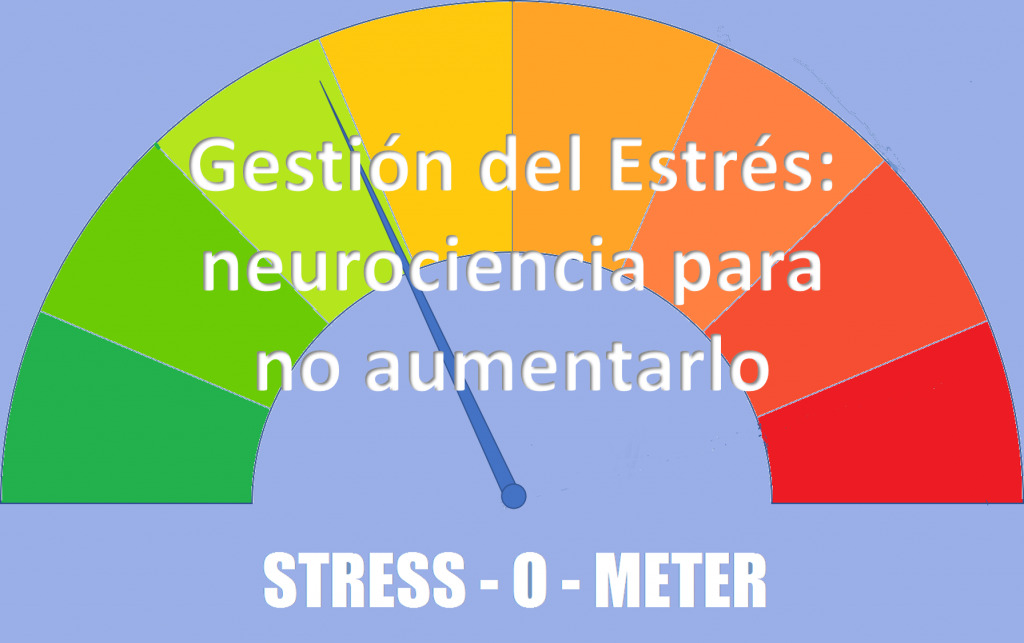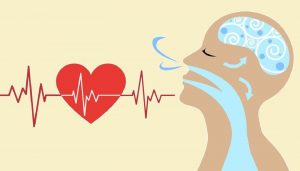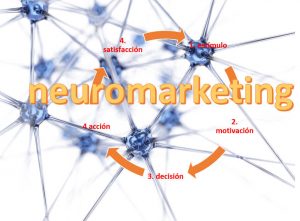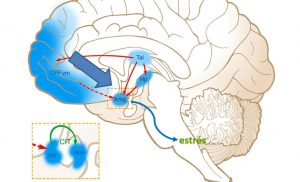In this post we will see strategies from the neuroscience for stress management. Depending on how we focus our thought and attention from the prefrontal cortex, PFC, we may increase our stress. We will understand in what situations it happens. But, the GABA neurons in the amygdala can help us to calm the fear and the consequent stress. We will learn to take advantage of it to improve our quality of life.
In the previous article, we started to see the neuroscience of stress. After that, we have little doubt that it is better not to increase stress than just trying to decrease it.
High stress negatively affects our quality of life. But, often, we become aware of the need to manage stress when it is already very high and has become distress, chronic stress or anxiety. Or when it is difficult to reduce it and/or when there are other collateral damages such as gastric ulcers, heart problems, etc.
In this post we will first go deeper into the neuroscience of stress seen from NeuroQuotient®. This will allow us to design strategies for stress management, especially to avoid increasing it. We will also see things that, in general, we are not aware we can do better about.
Stress, seen from neuroscience, is the response to cues of threat or fear. But, in humans, these threats may be only in our mind or intensified with it.
Let’s first to review some concepts of stress neuroscience that we have already discussed in the previous post. It is convenient that we keep them in mind so that we can better understand the stress management strategies.
First. Behind the stress is, mainly, the threat or fear system.
In this system work together perception (through the senses), the amygdala (limbic center of fear) and memory (hippocampus). If the memory indicates that the perceived cue is a danger, then it time to flight (if the threat is too great) or fighting (if it is possible to cope it successfully). If exposure to the threat lasts for a certain time (mora than 10 min), cortisol begins to act, which can have significant negative side effects.
But, human animals, with the PFC (prefrontal cortex), we can direct attention, imagine or remember. So the threat signals do not necessarily have to come from a direct perception of the senses. Obviously, depending on how we use the PFC, the result regarding stress management can be very different. That is, in the neuroscience of stress, the PFC is fundamental.
From NeuroQuotient® we use to say that sometimes we imagine lions where there are none and, probably, never there will be. Or that, in our mind, we turn mice into lions.
NeuroQuotient® turns neuroscience into something practical, in this case the neuroscience of stress.
But, also, with our thought, from the PFC, we can modify the meaning of the threat cues and, thanks to the GABA neurons, stop the activation of the amygdala and stress.
But, in the previous post we left pending the key of the neuroscience of stress to avoid increasing it. The prefrontal cortex also intervenes in it.
We said, that between the basolateral amygdala (the one that receives the danger signal) and the central amygdala (the one that triggers the fight or flight), there are cells (neurons) interspersed (CIT).
These CITs are neurons of the GABA (gamma aminobutyric acid) neurotransmitter. With its activation they slow down the central amygdala and stress is not started, since GABA is the main modulating neurotransmitter.
How are they activated? Well, with a message from the PFC saying, this signal, which seemed a danger, is a false alarm.
These days, post summer solstice days, some children still have firecrackers left. It is common to walk down the street and get scared. The hard noise triggers the amygdala, but soon we slow it down thinking something like:
‘Wow, it was just a firecracker’. That’s how we calm down.
Another quite common way to stop the amygdala and the consequent stress is to use tranquilizers and sleeping pills. Normally benzodiazepines. Diazepam (valium), alprazolam (tranquimazin), lorazepam (orfidal), etc. The benzodiazepines are ‘agonists’ of GABA, that is, they act in the same way in the receptors of the central amygdala.
We do not consider it advisable. Benzodiazepines create addiction. In addition, there are also GABA cells in the reward system, so they not only inhibit fear, but also the will to live.
Caffeine acts like noradrenaline (norepinephrine), helps wake up, but also activates the stress system.
Nor did we see in the previous post that norepinephrine intervenes in the start-up of stress. In connection with the amygdala – and from the locus coeruleus – noradrenaline activates the sympathetic nervous system and slows the parasympathetic nervous system.
Prior to adrenaline (epinephrine), which acts primarily in the body, noradrenaline is activated in the brain. An excess of noradrenaline involves brain stress.
In this review of stress neuroscience, we point it out now for two reasons:
First, because it is very important to maintain the balance between the two branches (sympathetic and parasympathetic) of the autonomic nervous system. We’ll see when we talk about how to reduce stress.
And second, even more pertinent, because in the noradrenaline receptors, and in the same way as she does, one of the most daily ‘wake-up’ acts: caffeine.
I remember a person who, to activate himself in the morning, and during the day, use to take several coffees. Then, to brake at night, he resorted to sleeping pills. Well, each one is responsible for himself. Maybe if this person had read this post he would have changed his stress management strategy.
Let’s see now what the main internal sources of stress are. Do you identify with any of these neuro behaviors?
Then, what can we do not increase stress, so as not to self-stress?
The first step is to become aware of how we activate or intensify the brain system of fear or threat. In many cases it has to do with how we use and focus our thinking, the PFC. We can ask ourselves the following questions:
1. Do you tend to worry (to pay attention in the future in a not positive way, paying too much attention to supposed threats)?
2. Do you have a trend to perfectionism (do you need everything to work out well)?
3. Do you want to encompass it, control it, everything, with a high level of self-demand?
4. Impatient; it’s hard to wait; Do you want it now?
5. Do you tend to see others as a threat to your interests?
6. Do you tend to ‘listen’ in negative to your bodily sensations of stress?
7. How is your daily dose of coffee?
8. How is your relationship with benzodiazepines?
By the way, if we find it difficult to identify these sources that make stress management difficult, with the NeuroQuotient® tool, we’ll find it out in 15 minutes.
Once identified our points of improvement, it is about finding alternative neuro-behaviors for these situations. Strategies arising from the understanding of the neuroscience of stress.
We have already realized that, in most cases, it is about avoiding or intensifying the signs of fear (not turning them into lions) that push the threat system to fight or flee, without it being necessary.
Once identified some neuro behaviors that make stress management difficult, let’s see some ideas on how to avoid increasing the stress.
Here there are some specific ideas for most of the previous points. They are referenced in the same way.
To ask ourselves, ‘what is really important’? is at the base of many of these ideas.
1. Instead of worrying, let’s decide what is important and, then take action. Don’t keep thinking about it. Excessive reflection with worry kills the action. Let’s take advantage of the energy directing it towards action to achieve what is important.
By worrying we also unleash energy, but we waste it; and we can end up somatizing stress.
And let’s try to change the focus in positive. It is as easy to think about what we are going to achieve than to imagine the opposite.
2. Perfectionism? Again, let’s decide what is important. Let’s forget the irrelevant details. Not everything needs the same level of precision. Prioritize. There are many things in which, if we fail, absolutely nothing happens. There are others, not so many, more important than it’s worth not to fail.
3. When we want to have everything under control, with high self-demand. We must bear in mind that not everything is possible at the same time. We have limited time resources, especially if we have to do it alone.
Then, once again, prioritize. Let’s organize ourselves to make better use of time. Let’s write down in the schedule when we are going to do something. Do not try to have everything in mind; in this way, we will only stress our PFC.
When we know what is important, we can deal with it and, at the same time, we stop worrying about what is not relevant.
On the other hand, regarding the non-important, we can send from the PFC (the thought and the focus) a message of tranquility to the amygdala. ‘I’m taking care of the important things. There is no reason for alarm ‘
And we continue with ideas to avoid increasing stress, following the items on the list for awareness
4. Impatience, in general, has to do with worry. We focus on the future and in a negative way. ‘The train does not come. I’ll be late’. Is it a matter of life or death that you arrive on time? If it’s so important, let’s get busy on it, let’s find an alternative to get it. If we can’t do anything, it does not make sense to worry.
5. Perceiving some other people as a threat. Often the lack of trust in someone makes us perceive them as a threat. Their simple presence or, just thinking about them, triggers our fear or threat system. And how, fortunately, it is not usual to ‘stick with others’, once again energy accumulates as stress within the body.
To avoid this, it is about changing the focus on these people. If they are important to us, of course. If they are not, then, just forget them.
Impatience with others has more to do with ‘the fight’ and with a level of demand, sometimes disproportionate. Watch out! Often, the ‘fight’ with others is also a way to get rid of stress and to avoid somatizing it.
In order not to increase stress when it has to do with the ‘fight’, there is another interesting approach. It has to do with trust and oxytocin, and it’s for more than one article. In some a way we advance it in a previous post: ’empathy to deactivate bullying’ (right at the end of the post).
6. Tendency to pay attention and interpret the body sensations in a negative way. If the symptoms are very intense, if it is serious, better go to the doctor. If not, we can pay attention to them, but without trying to interpret them or control them. And let them evolve by themselves. Our body is wise and by itself it will reach balance. This idea is partly related to the TIPI technique.
Attention! TIPI is much more than this (for more information you can inform yourself directly from its creator, Luc Nicon).
Finally, the exogenous elements. Drugs more or less
7. Regarding coffee, there is little to say. Do not abuse! Mainly, if our body is especially sensitive to caffeine.
8. If we need to take benzodiazepines, this mean that our stress level is already very high. Do not increase it, at least. And, please, not with caffeine.
Relaxing drugs cause drowsiness, counteracting it with caffeine is quite absurd. As an alternative to sleeping pills we can try something more natural, like valerian. As it smells very badly, there is no risk of addiction.
In general, for situations that are repeated and that start the amygdala and stress, it is important to change the focus and the meaning to trigger the CIT neurons as soon as possible.
Finally, please, remember that the NeuroQuotient® tool helps us understand the neuroscience of behavior. In this case the neuroscience of stress. And above all, with it we can see how our neuro behaviors help our satisfaction and well-being.




